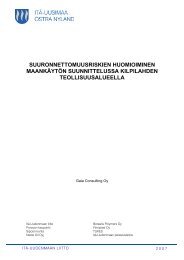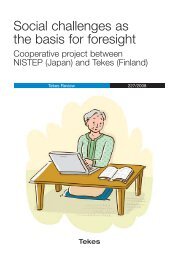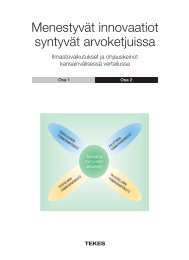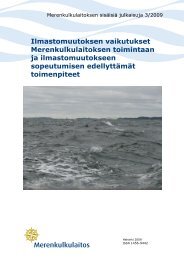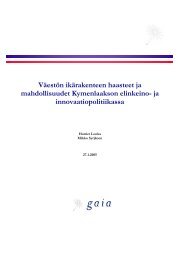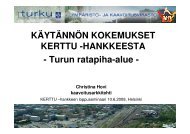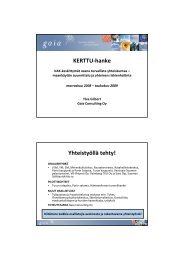Climate Risk Management in Finnish Development Cooperation - Gaia
Climate Risk Management in Finnish Development Cooperation - Gaia
Climate Risk Management in Finnish Development Cooperation - Gaia
You also want an ePaper? Increase the reach of your titles
YUMPU automatically turns print PDFs into web optimized ePapers that Google loves.
<strong>in</strong> 1991. Over 350,000 people were displaced at the start of the war from areas along the common<br />
border of the Tigray and Afar regions. An additional 95,000 Ethiopians were deported from Eritrea,<br />
and as the conflict escalated, people resid<strong>in</strong>g close to the borderl<strong>in</strong>es were evacuated. Drought<strong>in</strong>duced<br />
and fam<strong>in</strong>e-<strong>in</strong>duced displacements are chronic problems <strong>in</strong> Ethiopia and e.g. development<strong>in</strong>duced<br />
displacement occurs due to road construction. Relevant issues concern<strong>in</strong>g IDPs <strong>in</strong>clude the<br />
presence of landm<strong>in</strong>es, HIV/AIDS, and problems of the families of deceased soldiers. Refugees <strong>in</strong><br />
Ethiopia - pr<strong>in</strong>cipally Somalis, Sudanese, and Eritreans – often arrive as a result of ongo<strong>in</strong>g political<br />
and civil unrest <strong>in</strong> the Horn of Africa as well as natural disasters (mostly drought). Traffick<strong>in</strong>g,<br />
particularly of women and young girls, is another significant form of forced migration <strong>in</strong> Ethiopia. 102<br />
Implications to F<strong>in</strong>land<br />
In 2008, 668 Ethiopians immigrated to F<strong>in</strong>land. Out of the immigrants 430 were men and 238<br />
women. The figures <strong>in</strong>clude Ethiopians who have lived a year or more <strong>in</strong> F<strong>in</strong>land. The largest group<br />
of immigrants were 18-40 year old men. Overall, the amount of immigrants from Ethiopia to F<strong>in</strong>land<br />
is small <strong>in</strong> comparison to the amount of all immigrants arriv<strong>in</strong>g to F<strong>in</strong>land. Asylum seekers represent<br />
only a small proportion of Ethiopian immigrants as other reasons such as family, study and work<br />
immigration are more dom<strong>in</strong>ant. 103<br />
As mentioned <strong>in</strong> previous chapters, climate change could <strong>in</strong>crease potentials of conflict and<br />
therefore create refugees and asylum seekers even to F<strong>in</strong>land. <strong>Climate</strong> change itself will not create<br />
Ethiopian immigrants to F<strong>in</strong>land as people tend to move to local areas when liv<strong>in</strong>g conditions worsen.<br />
Already now, Ethiopia’s politicised ethnicity, where the country has been divided up <strong>in</strong>to a number<br />
of self-determ<strong>in</strong><strong>in</strong>g ethnically def<strong>in</strong>ed and adm<strong>in</strong>istrated territories, has left people less will<strong>in</strong>g to<br />
migrate <strong>in</strong>to regions adm<strong>in</strong>istered by ethnic groups other than their own 104 .<br />
In development cooperation, actions mentioned <strong>in</strong> previous chapters are also valid <strong>in</strong> the case of<br />
human displacement. <strong>Climate</strong> processes require long-term plann<strong>in</strong>g <strong>in</strong> development cooperation <strong>in</strong><br />
terms of adaptation measures and secur<strong>in</strong>g livelihoods. Sudden climate events may demand<br />
<strong>in</strong>creas<strong>in</strong>g amounts of emergency relief and humanitarian assistance from F<strong>in</strong>land and other donor<br />
countries. Both sudden and slow-onset disasters will require substantial protection and<br />
humanitarian assistance because displacement creates new, or exacerbates pre-exist<strong>in</strong>g<br />
vulnerabilities. F<strong>in</strong>land should support Ethiopia <strong>in</strong> reduc<strong>in</strong>g risks created by climate change and<br />
vulnerabilities caused by it. In addition, F<strong>in</strong>land can support Ethiopia <strong>in</strong> protect<strong>in</strong>g <strong>in</strong>dividuals<br />
displaced by the effects of climate change. Adaptation measures should cover protection of and<br />
assistance for the displaced. Measures to mitigate and reduce risks of disasters should <strong>in</strong>clude<br />
measures such as disaster risk mapp<strong>in</strong>g, early warn<strong>in</strong>g systems, predeterm<strong>in</strong>ation of evacuation<br />
routes, preposition<strong>in</strong>g of humanitarian aid, build<strong>in</strong>g capacities of local communities to deal with<br />
102 http://www.forcedmigration.org/browse/regional/ethiopia.htm<br />
103 Telephone discussion with Leena Hiljanen, F<strong>in</strong>nish Immigration Service/10.6.2009<br />
104 Morrissey (2008: 29)<br />
53



